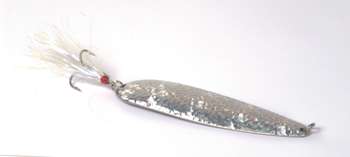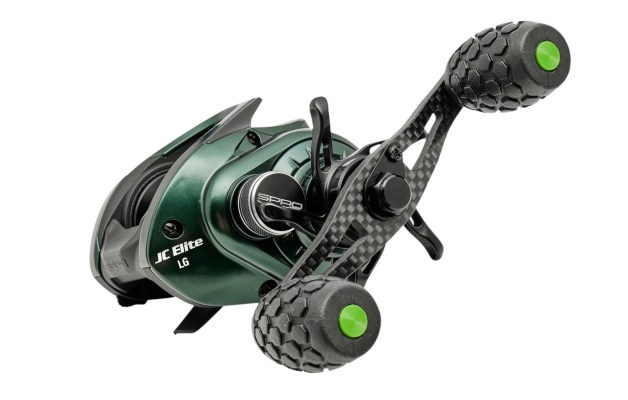
They say everything is bigger in Texas, and in this case it’s true. Meet the Nichols Flutter Spoon. It’s 6 inches long, weighs more than 1 1/2 ounces and could double as a garden trowel. The bass it catches are proportional to its hulking size.
Nichols Bait Co. proprietor Dave Nichols has been building baits since 1989 and has made spoons since the early ’90s. His original spoons were smaller than the Lake Fork Flutter Spoon, and, after proving to be a poor seller, he discontinued them. Nichols thought up the Lake Fork version after patenting a process that added some extra flash to his spinnerbait blades.
Nichols made them so that any angler — regardless of skill level — could reap the benefits of Texas trophy fisheries on their own lake.
“They’re so easy to use that if you learn how to use them well, it’s the only thing that you’re going to want to throw,” Nichols said.
Nichols found Rick Loomis, a Lake Fork guide of 16 years, a little more than a year ago when Nichols contacted Loomis about doing a fishing show in Texas.
“The host wanted to do a swimbait show, but Fork has seen so many swimbaits they don’t work as well as they used to five or six years ago,” Loomis said. “I told him I had this spoon that was hot, and he didn’t want to use it because he said it looked like a musky bait.
“He threw that swimbait a few times and didn’t get a bite even though we could see the fish on the graph. I threw the spoon out there and caught three fish in five casts. After that, he wanted one and we did the show on it,” Loomis said.
Since the show aired several months ago, interest in these spoons has soared. Loomis compares the spoons’ growing popularity to the swimbait trend.
“We were throwing swimbaits five and six years ago and doing well, but recently they just don’t work as much as before,” he said. “Now, the spoons are taking off here and in other parts of the country. We’re getting really good feedback from everyone.”
The spoon was created to offer an alternative to catching fish that were holding in deeper parts of lakes, such as the postspawn through the summer and into the fall. It is modeled after a Texas-sized gizzard shad.
“I was out fishing with Dave and when he pulled in a nice fish, it spit up a 12-inch gizzard shad, and I said, ‘The spoon looks just like that,'” Loomis said.
Loomis’ spoon-casting outfit is simple. He uses a medium-action, 7-foot Powell casting rod with 17-pound-test monofilament. He says these spoons need a soft rod to avoid tearing the bait from a bass’ mouth. He prefers his spoons in the shattered glass theme.
“About 90 percent of these fish are going to jump, and if your rod doesn’t have enough give, the hooks will tear free,” he says. He argues similarly for monofilament. You need the stretch to have a better chance of landing a spoon-hooked fish.
“These are usually bigger fish you’re catching, so their teeth will rub through fluorocarbon. Given the way you work the spoon, braid will get tangled in the hooks as it flutters.”
Loomis goes on to say proficiency with your sonar unit is a must to fish the Lake Fork spoon successfully.
“Most of the fish you’re catching are either suspended off the bottom or they’re near the bottom,” he says.
Part 2 of this three-part series details where and when Loomis throws the Lake Fork spoon and how to find the best structure on your graph.
See the picture of the regurgitated gizzard shad and the Lake Fork Flutter Spoon at www.nicholslures.com




